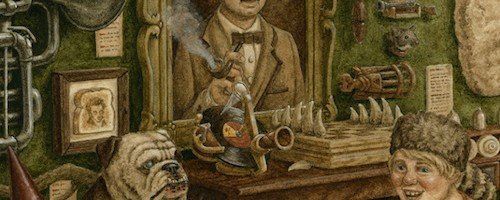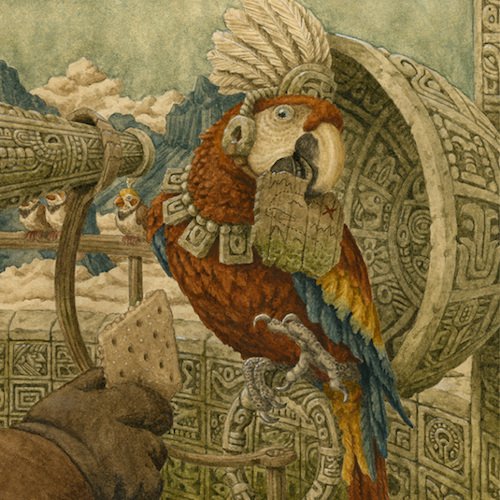Everything has a story. So opens the extraordinary new book Homer Henry Hudson’s Curio Museum by first time author/illustrator Zack Rock, and yes, as the whimsical title implies, not only does this museum itself have a story, every single object within the walls of this old schoolhouse has its own eccentric life. And if you happen to be the curator of this museum, you’d better know how to tell a story. No problem. Homer Henry Hudson is your man, or should I say, dog.
 Homer, an old bulldog, is like one of the curio items in his museum: worn around the edges, perhaps a little out of place, full of quirk, and resonant with history. He may have a cloudy eye, but his vision is clear, and his taste for adventure knows no bounds. You see, everything in the museum has been discovered, collected, and/or presented to Homer over his long life as an explorer, and over time, the items have become totems – the material representation of past adventures. His first discovery, a Conatusaurus Skull (#0001) ‘no bigger than a chicken and as rubbish at flying’, found in the soil of his family’s farm, awakens an ‘unquenchable curiosity’ about the world and sets Homer on a life-long quest to uncover, to put it mildly, the unusual.
Homer, an old bulldog, is like one of the curio items in his museum: worn around the edges, perhaps a little out of place, full of quirk, and resonant with history. He may have a cloudy eye, but his vision is clear, and his taste for adventure knows no bounds. You see, everything in the museum has been discovered, collected, and/or presented to Homer over his long life as an explorer, and over time, the items have become totems – the material representation of past adventures. His first discovery, a Conatusaurus Skull (#0001) ‘no bigger than a chicken and as rubbish at flying’, found in the soil of his family’s farm, awakens an ‘unquenchable curiosity’ about the world and sets Homer on a life-long quest to uncover, to put it mildly, the unusual.
Ostensibly, Homer’s job is to keep the museum presentable for the visitors, and to ‘sit quiet as a curio’ while they explore the exhibits. Each item is accompanied by a description and a personal note as to its provenance. There are thousands of objects in the museum, but it is always his hope that the visitors will gravitate toward the few ‘favourite bits and bobs’ that have become emblematic of his travels. Some are stand-alone objects, like the Radial Tide Diviner (#0023), a device used by soothsayers on Calypso Island to ‘predict the future based on tidal pattern.’ Unfortunately for the Calypsoian civilization, the entire island slipped into the Ionian Sea after an earthquake in 487BC. “Shame the device never warned the soothsayers that their island sat on a massive fault line,” writes Homer.
Other objects provide a through-line from one part of Homer’s life to another. A young girl who gives the explorer a Nóttlandian Stuffed Animal (#1981) in gratitude for plucking her out of the rebels’ grasp makes an appearance later in the book when she presents Homer with the Manneken Mort of King Ingmar (#3415) – a parting gift from her deceased father King Ingmar for saving his daughter’s life. A Manneken Mort is a figure made of fabric bands, each band representing one story in a Nóttlandian’s life. When a person passes away, friends and family gather, and as as each story is recited, another band is added. Like the discovery of the Conatusaurus Skull, upon seeing the Manneken Mort, Henry’s wanderlust is stirred. Has his last band been woven? More importantly, does his explorer’s hat still fit?
Zack Rock’s sepia-infused illustrations in Homer Henry Hudson’s Curio Museum are little masterpieces of humour, imagination, and of course, gobsmacking beauty. Anyone who has ever picked up a watercolour brush will understand how little control one has over the medium, and given the complexity of Rock’s illustrations, it’s no surprise that he does a significant amount of planning before brush hits paper. “Usually I make a small, loose(ish) thumbnail sketch of the scene, just to get the composition down. Once that’s resolved, I do a larger, more detailed final sketch. That gets blown up on Photoshop and printed out so I can transfer it over to watercolour paper using a lightbox. If I have any hesitation about the colours, I do a quick digital mock-up in Photoshop before the painting begins. After that there’s no turning back; I’m walking the tightrope with only my brush for balance.”
There is a completeness of vision to Rock’s Homer Henry Hudson’s Curio Museum that is cinematic, like a Terry Gilliam film. It is a very particular and artistically playful world, matched in tone and style by Rock’s equally playful word choices. One could spend days with this book and still find visual and narrative treasures anew, like a portrait of Kafka (with antennae) tucked into the corner of a wall, or Homer’s amusing description of how he collected an ornate stone head: “I charged my plane toward the hidden city like a bull…though I lack provisions, I rammed ahead. Though I flew through a porridge of fog, I rammed ahead. And then I rammed a head.” Brilliant.
Though a bulldog, Homer Henry Hudson is the embodiment of that most human of qualities – the desire to find meaning in life, even in the of smallest objects and the most seemingly unimportant events.
“Look around. Look closer. That bit of cloud may be the first puff of a newborn volcano. Those tree bark scratches may be an obscure secret code. That discarded rock might once have been, or may someday be, the cornerstone of a great kingdom. Everything has a story.”
 The old bulldog’s declaration at the beginning of the book invites us in to the world of an ‘eccentric explorer extraordinaire’, but by the end of the book, it takes on a deeper resonance. A call to be mindful, to seek out stories, and most importantly, to be the story – to keep adding those bands to our own Manneken Morts, regardless of our age, or breed.
The old bulldog’s declaration at the beginning of the book invites us in to the world of an ‘eccentric explorer extraordinaire’, but by the end of the book, it takes on a deeper resonance. A call to be mindful, to seek out stories, and most importantly, to be the story – to keep adding those bands to our own Manneken Morts, regardless of our age, or breed.
According to his website, Zack Rock is a writer, illustrator, and ‘cardigan enthusiast.’ Born in Cedar Rapids, Iowa, Rock spent most of his childhood in California, a state not particularly synonymous with cardigan weather. He received his Master’s in Children’s Book Illustration from the Cambridge School of Art in Cambridge, England – suspected source of his love for light, buttoned sweaters. His work has appeared in magazines, newspapers, video games, comic books, and on album covers. Homer Henry Hudson’s Curio Museum is his first picture book, but I have it on good authority that others may be in the queue.
Homer Henry Hudson’s Curio Museum (Creative Editions, 2014) by Zack Rock






